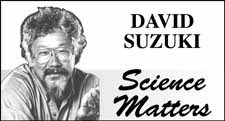The past few weeks have marked an interesting time for salmon and salmon farming in B.C. The first commercial-scale ocean-based closed-containment salmon farm tanks are being installed near Campbell River, B.C., and the Global Aquaculture Alliance (GAA) closed its public comment period on draft certification standards for salmon farms. Meanwhile, a survey commissioned by the Pacific Salmon Foundation and the Fraser Basin Council showed that most British Columbians support making wild Pacific salmon the province's official fish. The Cohen Commission inquiry into Fraser River sockeye salmon also resumed its hearings.
Some of this activity illustrates our struggle to figure out whether or not farming salmon can be sustainable. It's an important but difficult question, in part because the definition of "sustainable" is hard to pin down. And, along with issues such as sea lice and other challenges with salmon farming, raising carnivorous fish like salmon will continue to raise questions about sustainability unless we find a way to feed them that doesn't lead to the depletion of other wild fish. It's necessary to be clear about whether we're getting closer to working in balance with nature or whether we are just trying things out without understanding the full impacts.
For example, the proposed GAA standards tell us little more than that the producers are obeying the law. Although the industry trade association asserts that its Best Aquaculture Practices "assure healthful foods produced through environmentally and socially responsible means", the standards don't address the most critical environmental and social threats of open net pen salmon farming, such as disease, parasites, and sustainable feed sources.
Another example of the controversy around trying to achieve better salmon farming has to do with integrated multi-trophic aquaculture, or IMTA. With IMTA, waste from raising one aquaculture species, like salmon, is used as food or fertilizer for other species grown at the same farm site. And so, for example, putting shellfish farms below a salmon farm helps feed the shellfish while cleaning up some of the mess and potential damage of waste from the fish farm. Cooke Aquaculture on Canada's East Coast is now testing the method, but it's actually an ancient practice, developed in China for food production thousands of years ago.
Although it has promising applications, it doesn't move salmon farming out of the red or "Avoid" category of ranking systems like SeaChoice or the Monterey Bay Aquarium. To start, it doesn't change some of the fundamental challenges of sea lice and disease from farms getting into the wild, nor does it change the fact that intensive open net cage aquaculture has a heavy impact on ecosystems. On top of that, it doesn't address the crucial issue of what we feed to the farmed salmon.
And we don't have enough information about how much improvement IMTA actually delivers. This makes a recent announcement by Loblaw that it will carry and promote IMTA farmed salmon from Canada's East Coast frustrating and disappointing. The company has taken significant steps for seafood sustainability, but branding and promoting IMTA salmon, labelled WiseSource, muddies the waters.
At best, IMTA is one small step on a long ladder. Consumers don't always have time to research every label, and so we must be rigorous about what we decide to promote.
If we want to farm salmon and protect wild salmon and ecosystems, the best approach involves closed containment systems that separate farmed fish from wild fish. The four closed containment tanks being installed by AgriMarine Inc. near Campbell River are a start, as is the SweetSpring Salmon land-based system that supplies Overwaitea stores. SweetSpring does an excellent job of reducing the use of wild fish for feed, but no matter what systems we use, we must diversify into farmed species that are lower down on the food chain than salmon, cod, or tuna, so that we can better manage the resources needed to feed the fish and shellfish we produce through aquaculture.
And if we continue to farm salmon, we must continue to find substitute feed sources that don't lead to the depletion of other fish stocks.
British Columbians really do treasure wild salmon, but if we want to make it a symbol of the province, we must do everything we can to ensure that it remains a living symbol.Learn more at www.davidsuzuki.org.




